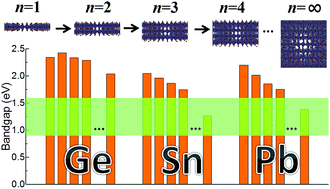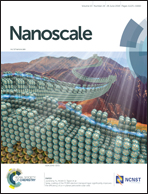Tin and germanium based two-dimensional Ruddlesden–Popper hybrid perovskites for potential lead-free photovoltaic and photoelectronic applications†
Abstract
Despite their high power conversion efficiency, the commercial applications of hybrid organic–inorganic lead (Pb) halide perovskite based solar cells are still hampered by concerns about the toxicity of Pb and the structural stability in open air. Herein, based on density-functional theory computation, we show that lead-free tin (Sn) and germanium (Ge) based two-dimensional (2D) Ruddlesden–Popper hybrid organic–inorganic perovskites with a thickness of a few unit-cells, BA2MAn−1MnI3n+1 (M = Sn or Ge, n = 2–4), possess desirable electronic, excitonic and light absorption properties, thereby showing promise for photovoltaic and/or photoelectronic applications. In particular, we show that by increasing the layer thickness of the Sn-based 2D perovskites, the bandgap can be lowered towards the optimal range (0.9–1.6 eV) for solar cells. Meanwhile, the exciton binding energy is reduced to a more optimal value. In addition, theoretical assessment indicates that the thermodynamic stability of Sn-/Ge-based 2D perovskites is notably enhanced compared to that of their 3D analogues. These features render the Sn-/Ge-based 2D hybrid perovskites with a thickness of a few tens of unit cells promising lead-free perovskites with much improved structural stabilities for photovoltaic and/or photoelectronic applications.

- This article is part of the themed collection: International Year of the Periodic Table : From Pb and Sn Perovskites to the Next Generation


 Please wait while we load your content...
Please wait while we load your content...
